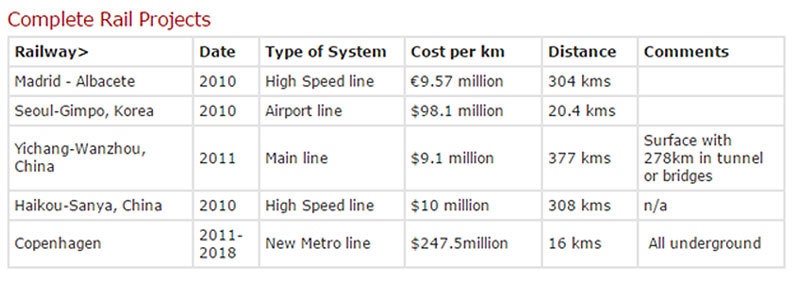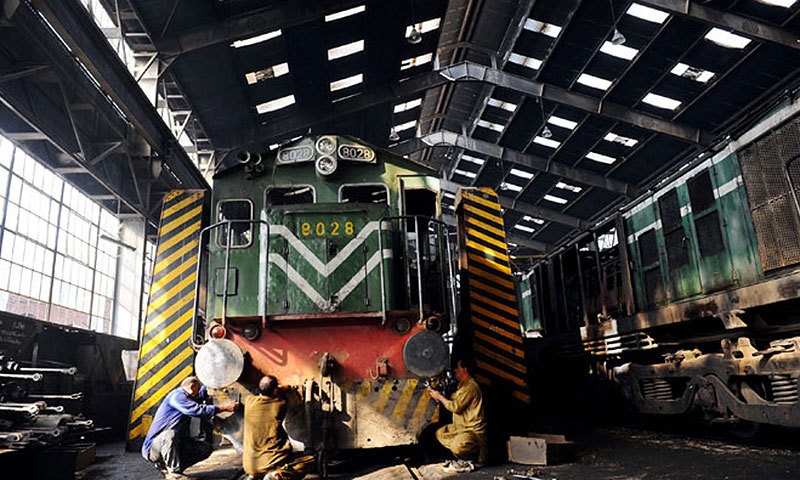Thinking fast and slow is what Daniel Kahneman, the Nobel Laureate in Economics, thinks humans do. Planning fast and moving slow is what Pakistan Railways does.
With cumulative liabilities reaching 74 billion Rupees, Pakistan Railways is one state-owned enterprise that has not delivered a profit in ages. Despite when revenues increase, the expenses increase even faster, returning even bigger annual losses.
With such a dismal outlook, optimism still abounds at the Prime Minister’s Secretariat where plans for a high-speed rail link between Peshawar and Karachi have taken root.
One wonders when Pakistan has failed in running slow trains, how can it succeed in running fast ones. Wouldn’t planning fast and moving slow be yet another failed experiment with Pakistan Railways?
Also read: ‘Green train’ signals PR revival, says PM
In April 2014, Pakistan Railways took out a half-page advertisement in The Financial Times soliciting interest in a high-speed rail link. The Sunday Times reported the 6.6 billion pound project would reduce the travel time for the 700-mile journey from 18 to seven hours. The cost may seem high. However, at $10 million per km, it appears comparable to other similar projects in developing countries.
 |
| Source: http://www.railway-technical.com/finance.shtml. |
High-speed rails in Pakistan are not going to be as fast as the French TGV or the Japanese Shinkansen, which operate at speeds over 300 km/h. A conservative estimate of the average operating speed for the high-speed rail in Pakistan is between 150 to 200 km/h.
It may not sound impressive, but this is the average operating train speeds in Canada and the US. If the trains in Pakistan can run at 150 km/h, train riders will be as fast and furious as their North American counterparts.
However, it is important to have a look at how Pakistan Railways veered off-track.
The bad ways of Railways
Nisar Ahmed Abro, a Station in-charge in Sindh, knows intimately well of what ails Pakistan Railways. Speaking to The New York Times in 2013, Mr. Abro quipped: “The railways are the true image of our country. If you want to see Pakistan, see its railways.” Mr. Abro has made the right prognosis. There is nothing more wrong with the Railways than what is already wrong with Pakistan and its other public sector utilities.
Corruption, mismanagement, nepotism, and lack of professional expertise plague the Railways and other relics of a fast shrinking public sector in Pakistan.
It is important to understand that Pakistan Railways is dying a slow death. In the process, its assets are shrinking and so is the level and scope of services the Railway provides.
In 1986, the consulting arm of the Canadian Pacific Railways won a contract to propose specifications for a computerised management information system. The Globe and Mail in Canada highlighted the deal and reported that Pakistan Railways operated 8,800 km of track and carried 11 million tonnes of freight and 100 million passengers.
That was then.
The latest statistics from Pakistan Railways paint a disappointing picture. Down from a 100 million passengers, Pakistan Railways carried a mere 47 million passengers in the 2013-14 fiscal year. From 11 million tonnes of freight in 1986, the volume was down to 1.6 million tonnes. Despite the drastic decline in services, Railways still carried a workforce of 80,000 employees.
The Railways finally got around to computerising parts of its information management in November 2007 when the electronic ticketing system was launched. Recall, Canadians were awarded a contract in 1986 to do its feasibility. It took Railways only 21 years to take the next step. However, the system remained operational for a mere three months! It was back to the good old days and the good old ways for Railways.
Railways infrastructure is insufficient to meet the demand and is in poor state. To help move a nation of 180 million, Pakistan Railways has fewer than 500 locomotives of which only 20 per cent are operational. The rest are either too old or too damaged to operate.
Railways’ own records show that even in the early 80s, the locomotive fleet stood at over 950 and the number of passenger coaches exceeded 2,370. By 2013-14, Railways was left with only 1,434 coaches. Also, Railways in the early 80s loaded, on average, 600,000 freight wagons. By 2013-14, that number was down to 76,300.
Also read: Arrival and departure: a day at the station
It is quite convenient to blame the political administration and bureaucrats for the sorry state of Railways’ affairs. This, however, will be wrong. The very masses, who suffer at the hands of Railways, seldom miss an opportunity to destroy the very infrastructure that they desperately need and have paid for with their taxes.
After the death of Benazir Bhutto, enraged masses torched 137 coaches and 22 locomotives. In addition, terrorist violence and accidents have destroyed even more infrastructure.
The state of Railways affairs is so bad that one cannot tell with certainty the extent of financial losses. At the same time, the political operatives are keen to deliver the good news about the Railways.
Last July, a senior administrator boasted to the media of generating 25 billion Rupees in revenue in 2013-14, resulting in an “increase of Rs 7 billion in the national kitty,” wrote a newspaper.
There is, however, a problem. The Auditor General of Pakistan (AGP) is not equally enthralled about the Railways’ performance. The AGP’s annual report raises alarm about the Railways’ losses surging to 32.5 billion Rupees for the same fiscal year.
The AGP reported the gross earnings to be 22.8, and not 25, billion Rupees against 55.3 billion Rupees in operating working expenditure. It is true that Railways earned more in 2013-14 than it did in 2012-13. However, its expenses rose as well, negating the benefits of increased revenues.
The looming losses did not deter the government from boasting to the IMF of a stellar Railways performance. In a letter of intent addressed to the IMF’s managing director, the government claimed to have improved Railways’ “revenue in FY 2013/14 by 32 per cent.” Never mind, Railways own published statistics reveal a 26 per cent increase in revenue over the last fiscal year.
The government further claims to have “increased revenue by over 50 per cent in the first nine months of FY 2014/15.” There is no mention in the letter of the mounting expenditures against the increased revenues.
How to put railways back on track
Given the culture of entitlement that lets college students ride public transit free or political patronage that keeps adding unneeded employees to the Railways’ bloated workforce, it is rather naïve to hope for a turnaround in Pakistan Railways with structural reforms.
The skills needed to revitalise a restructured Railways do not exist with the employees or the administrators.
There is no option, but to privatise Pakistan Railways. The inevitable privatisation can only be delayed, but not avoided. The downside of the delay is that vested interests will be able to scavenge even more Railways assets.
Remember, Railways today is merely a shadow of what it once was. Its land holdings, operating fleet of locomotives and cars has shrunk. It carries much fewer passengers and freight today than it did even two decades ago.
The attempts to privatise Railways always end up in the Superior Courts where Railways employees argue for their God-given right to a public sector employment. The Superior Courts must consider the balance between the welfare of the 180-million individuals against the employment guarantee for the 80,000 Pakistan Railway employees who are responsible for an increase of billions of Rupees each year to the nation’s collective debt.
Also read: Reshaping railway a Herculean task
Courts have also shown concern for low-income commuters who may be forced to pay higher fares under privatised rail operations. This indeed, is a valid concern.
However, it does not require the State to run Railways. The Benazir Income Support Programme is a good example of subsiding low-income households that could be expanded to include commuting subsidies so that the government is freed from running trains, flying planes, and steering buses.
In the interim, when the battle to privatise Railways continues, one can restructure Railways to slow down, if not reverse, the rot.
The breakdown of expenses reveals that Railways spends a large sum on maintenance and administration. This can be addressed by segmenting the Railways into smaller functional units with transparent administrative setups.
For instance, the passenger and freight operations may be segregated into independent entities, namely Pakistan Passenger Railways and Pakistan Freight Railways. The locomotives may be divided as per the current demand for service for freight and passenger transportation. The passenger cars and freight wagons are easy to assign. The maintenance departments should be consolidated under a separate independent entity that would serve both Freight and Passenger Railways.
 |
| Source: Data retrieved from Pakistan Railways annual report. |
The government has already established Real Estate Development & Marketing Company (REDMCO) to manage and exploit the potential of whatever is left of the Railways public lands.
I recommend that the existing railway tracks, the accompanying rights-of-way, and other immobile assets, including Stations be consolidated under REDMCO with the goal for the entity to be an asset manager rather than one with the sole mandate to dispose of land to speculators.
Even with privatisation, it may be prudent to maintain railway stations and tracks under the public sector to allow late entrants from the private sector to make competitive bids for the use of the same infrastructure.
If the tracks, rights-of-way, and stations are privatised, they will result in new private sector monopolies who will have little incentive to be efficient or cost effective.
Think of the tracks as Motorways. Imagine if the Motorways were sold to Daewoo, who could have refused to allow competition to operate buses and trucks. Operating efficiencies would have declined and user costs increased as a result.
Also read: Pakistan Railways; off track and into ruin
A good starting point towards privatisation will be to abolish the Ministry of Railways. Railway ministries do not exist in developed countries. Even in European countries where rail transportation is much more pronounced, railways are not a standalone ministry. By abolishing the Ministry of Railways, one can eliminate the administrative redundancy that exists between the Ministry and Pakistan Railways.
A Ministry of Transportation and Infrastructure should amalgamate the collective portfolios of Ministry of Railways, Ministry of Ports and Shipping, and Ministry of Housing and Works. This will not only save costs but also improve operating efficiencies by ensuring better coordination between inter-related departments and corporations that are spread across several ministries. Pakistan Railways and PIA could both be under the Ministry of Transportation and Infrastructure until such time that these entities are privatised.
Railways should also be forced to abandon all tangential operations that are not core to its mission. For its employees and their dependents, Railways run numerous hospitals and schools. These are the non-productive use of Railways’ capital and other assets/infrastructure.
These facilities should be handed over (better sold) to respective municipal and provincial authorities. Instead of operating these large establishments at a financial loss, Railways should instead provide health insurance to its employees and education grants to low-income employees. The trade-off will result in savings and, more importantly, it will help the Railways to focus more on its core mission.
Doing the same without success for years and hoping for a better outcome in the future is a clear sign of administrative and imaginative failure. Whatever the State has done, under a variety of civilian and military regimes, it has failed to stop bleeding at Pakistan Railways.
A gradual and sustained series of steps, starting with restructuring and ending with privatisation, are a must.
If not, be prepared to assume billions more in national debt to keep the 80,000 Railway employees working in the public sector.













































